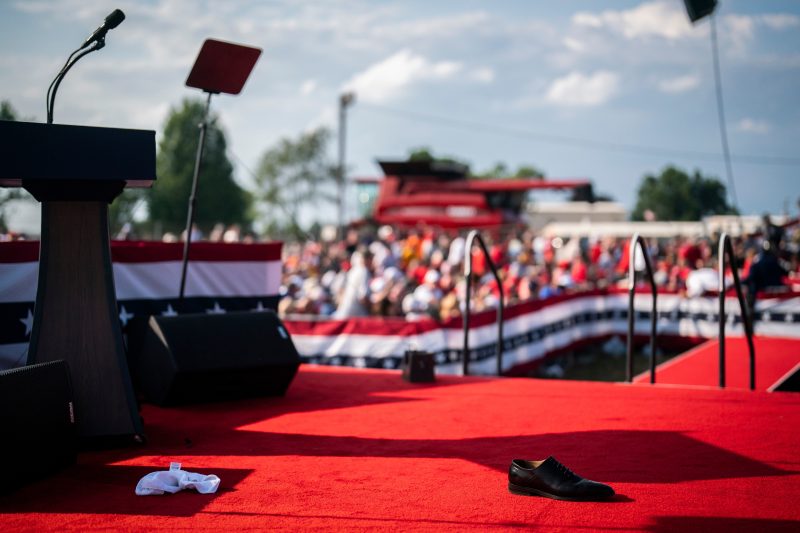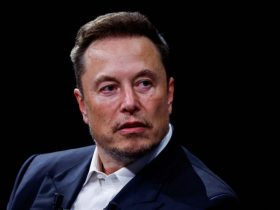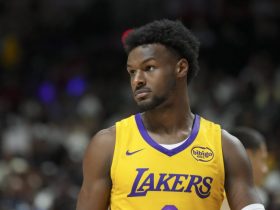On the first night after Donald Trump was injured in an assassination attempt in Butler, Pa., some supporters and allies, including campaign staff, immediately began blaming President Joe Biden and Democrats before any information was available about the shooter or his possible motive. Trump himself didn’t go there. In his first public statements after the July 13 shooting, Trump thanked law enforcement, offered condolences to the rallygoers killed and wounded, and called for unity.
But his tone changed in recent weeks, as the Republican presidential nominee began promoting such conspiracy theories as those that label the assassination attempt an “inside job” by government agencies or make up Democratic ties to lawyers representing the shooter’s parents. Trump and his running mate, Sen. JD Vance (R-Ohio), frequently portray the attempt as part of efforts by political opponents to prevent the former president from returning to power.
“I probably took a bullet to the head because of the things that they say about me,” Trump said at Tuesday’s ABC News debate with Vice President Kamala Harris, referring to the bullet or bullet fragment that authorities said grazed his right ear.
The photo of Trump raising his fist with blood on his face has supplanted his mug shot as the defining image of his campaign, adorning everything from T-shirts to Christmas ornaments, and symbolizing the feeling of defiance that Trump has made core to his political persona. Republicans’ new rallying cry became the “Fight! Fight! Fight!” chant inspired by Trump’s first words after getting shot.
His frequent retellings of what happened in Butler serve to deepen his bond with his supporters by fostering a collective experience of overcoming adversity. That shared feeling gets intensified by a perceived indifference from the media and the rest of the country, as attention quickly moved on from the shooting to Trump’s selection of Vance and Harris’s replacement of Biden as the Democratic nominee. And as with previous MAGA myths, such as unsubstantiated claims of election fraud, Trump’s supporters bring him information and suspicions that he amplifies and validates, creating a mutually reinforcing feedback loop.
“The more we see what happened that day, the more suspicious it all looks,” right-wing podcast host Monica Crowley said in an interview with Trump released on Aug. 29. “It looks like the three-letter agencies are slow-walking a lot of this evidence, a lot of the videos, etc. Does it look increasingly to you like this was a suspicious, maybe even inside job?”
“It’s very suspicious,” Trump replied. “The more you see it, the more you start to say, ‘There could be something else.’”
Trump campaign senior adviser Brian Hughes said: “President Trump wants to ensure we learn where failures happened and how to prevent them in the future, because the American people, especially Corey’s family and those who were wounded, deserve to know the truth.”
Researchers who study political violence said these words, images and emotions have the dual effect of mobilizing Trump’s supporters to vote for him and delegitimizing the outcome in case he loses. They also said Trump’s emphasis on the shooting could inspire some of his supporters to resort to violence in his defense.
“It is creating a permission structure for at least some people to want to take matters into their own hands,” said Matt Dallek, a George Washington University professor who studies the conservative movement and is working on a book about presidential assassination attempts and political violence in the 20th century. “It operates similarly to the ‘big lie’ about the 2020 election being stolen, and therein lies the danger to the country.”
Investigators have yet to identify a motive for the shooter, Thomas Matthew Crooks, 20, who was killed at the scene by a Secret Service sniper. Authorities said Crooks’s phone had pictures of Biden and a member of the British royal family as well as Trump, and they have found no sign of an ideological or political motive. Instead, the available evidence points to Crooks as a troubled young man like many of those behind past assassination attempts or, more often, school shootings.
A series of lapses made it so Crooks was able to take multiple shots at Trump using his father’s rifle from about 150 yards from where Trump was speaking, firing from the roof of a building where local police were staged. Police searched for Crooks as a reported suspicious person for 30 minutes before Trump’s detail found out, and one officer found him on the roof but had to retreat just before Crooks opened fire.
The Secret Service repeatedly turned down the Trump campaign’s requests for additional resources as the agency struggled to keep up with expanding protection needs for more than two dozen people. Director Kimberly Cheatle resigned under pressure in July, and there are ongoing investigations by congressional committees, the FBI and Homeland Security’s inspector general. No evidence has emerged of White House involvement in resource decisions.
The shock of freak events like assassinations almost always tempt imaginations, with loose ends about the political murders of the 1960s that linger still today. In the case of the Butler rally, the embarrassing revelations and stubborn unknowns have given Trump and his supporters ample jumping-off points. Some on the left have also engaged with unfounded suspicions about the source and nature of Trump’s injury. In a recent podcast interview, Trump pointed to FBI Director Christopher A. Wray’s initial uncertainty in congressional testimony about what hit Trump’s ear as reason to distrust him; Wray, whom Trump appointed, clarified that the former president was injured by a bullet or fragment.
“This is all set up to prime his base to believe that, if his loses in November, the Democrats have once again stolen the election, that Harris is illegitimate, and they should in some respects come to his defense,” said Barbara F. Walter, a professor at the University of California at San Diego and the author of “How Civil Wars Start and How to Stop Them.” If his polls deteriorate in coming weeks and it looks like he may lose, she added, “he’s going to ratchet up that narrative even further.”
‘Don’t they have to kill you now?’
The prospect of an assassination was on the minds of some Trump supporters long before the Butler rally. In December 2020, Trump told friends he feared Iran might try to kill him as retaliation for the drone strike he ordered to kill Maj. Gen. Qasem Soleimani, according to the book “The Divider” by Peter Baker and Susan Glasser. Fans at Trump’s Mar-a-Lago Club would sometimes come up to him and warn he shouldn’t pick a running mate more favorable to the “deep state” or the supposed ill-defined cabal would take him out, according to people familiar with those conversations, who spoke on the condition of anonymity to reveal private interactions.
Last year, as Trump stared down four separate criminal cases, he repeatedly passed on invitations to speculate that an assassination attempt could be in his future. “Are you worried that they’re going to try and kill you?” Tucker Carlson asked Trump in an interview released on the same night as the first primary debate, in which Trump did not participate. Trump didn’t directly answer, and Carlson tried again: “Don’t they have to kill you now?” Trump again changed the subject.
The eventual attempt on Trump’s life left him unusually spiritual and amazed to be alive, according to people who spoke to him immediately after. He stayed relatively quiet through the start of the Republican National Convention that opened just two days later.
That week of speeches and meetings quickly developed the accepted meaning of the assassination attempt within the party and movement. The “fight” chant became a constant refrain. Photos of Trump’s raised fist frequented the arena screens and, before long, the merchandise available outside. There would be shirts proclaiming “Still Standing … Impeached, Arrested, Convicted & Shot” and “You Missed.” Some delegates wore paper flaps over their ears in solidarity with Trump’s bandage.
“When he stood up after being shot in the face, bloodied, and put his hand up, I thought, at that moment, that was a transformation. This was no longer a man,” Carlson said in his speech on the convention’s final night. “I think it was divine intervention. But the effect that it had on Donald Trump — he was no longer just a political party’s nominee, or a former president, or a future president. This was the leader of a nation.”
Trump’s staff said ahead of time that his own speech for that night would transcend his usual controversies and insults, showing the former president like Americans were not used to seeing him. He began with a dramatic retelling of the assassination attempt, saying it would be the only time because it was “too painful.” He was joined onstage by the firefighter uniform of slain rallygoer Corey Comperatore and at one point walked over to kiss the white helmet.
As the speech went on, Trump returned to form, vilifying immigrants and demanding the dismissal of the criminal cases against him. By the end of the month, Trump would acknowledge how short the respite lasted.
“They all said, ‘Trump is going to be a nice man now. He came close to death.’ And I really agreed with that for about eight hours or so,” he said at a July 31 rally in Harrisburg, Pa. “So, I was nice for about, what would you say, three, four, or five hours, and then I said, ‘These are bad people. We have to win this battle.’”
‘A lot of coincidences’
Notwithstanding his caveat at the convention, Trump proceeded to recount the shooting again and again. At the July 31 rally in Harrisburg, he marveled that the Butler rally hadn’t turned into a stampede when the gunshots rang out. He singled out a man wearing a green floppy hat in the bleachers behind him, visible in news footage standing and staring at Trump while others ducked.
People in the crowd started shouting, “He’s here!” and pointing Trump’s attention to a man standing in the audience in Harrisburg. “Wow, that’s great,” Trump said. “You can be in a foxhole with me anytime, man.”
The person standing to accept to adulation in Harrisburg was not, in fact, the man in the green floppy hat whom Trump had been describing. That man asked not to be identified.
Still, the observation that the rally attendees in Butler stayed and watched Trump rather than flee quickly became a popular feature of the story, usually offered as testament to their courage and dedication to Trump — making the brush with disaster something they survived together.
“The people of Butler County didn’t run,” said Jim Hulings, chairman of the county’s Republican committee, who was seated in the front row. “I didn’t duck. I stood up on my chair.”
That night, after Trump took off in his plane and police cleared the fairgrounds where the rally had been, someone down the road set off fireworks. People put out Trump signs and banners and spray-painted “FIGHT” on the streets. Hulings remembered driving the next day to show his wife the fairgrounds but it was blocked off by investigators, and he noticed the church parking lots were full.
“I’ve never met anybody who says, ‘Hey, there’s a conspiracy,’” he said. “A lot of people say there’s a lot of coincidences. Some of us grew up with the John F. Kennedy assassination, the Robert Kennedy assassination, the Martin Luther King assassination. They still haven’t told us what happened with John F. Kennedy. We’ll never know all the facts because they’ll cover it up. Why would they do that?”
An anonymous petition circulating online gathered more than 7,000 signatures to ask the county judge to impanel a grand jury to investigate the assassination attempt, alleging that federal agencies have conflicts of interest and “possible perceived corruption.”
Trump allies and surrogates are already echoing his language or going further. In a Sept. 6 radio interview, Sen. Ron Johnson (R-Wis.) drew a line connecting the JFK assassination, the downfall of President Richard M. Nixon and the Butler shooting.
“We’ll probably never know because there’s a reason you call it the deep state,” he said. “It’s very deep. It’s very pervasive.”








